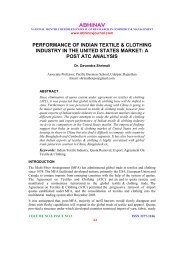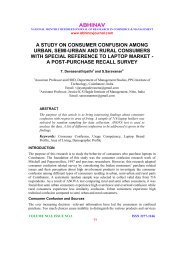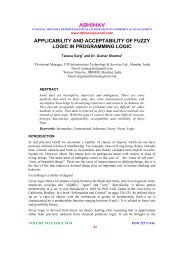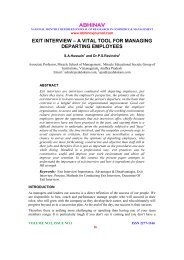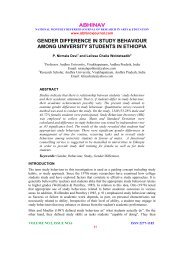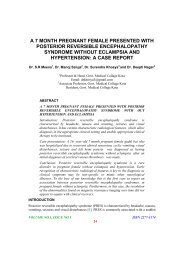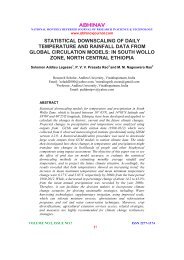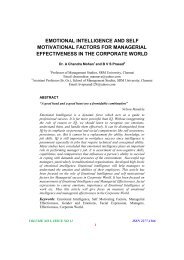What does Conflict Resolution Meant? Can it be Resolved?
What does Conflict Resolution Meant? Can it be Resolved?
What does Conflict Resolution Meant? Can it be Resolved?
You also want an ePaper? Increase the reach of your titles
YUMPU automatically turns print PDFs into web optimized ePapers that Google loves.
ABHINAVNATIONAL MONTHLY REFEREED JOURNAL OF RESEARCH IN ARTS & EDUCATIONwww.abhinavjournal.comWHAT DOES CONFLICT RESOLUTION MEANT?CAN IT BE RESOLVED?Dagne Shibru AbateResearch Scholar, Andhra Univers<strong>it</strong>y, Visakhapatnam, IndiaEmail: dagneshibru2009@yahoo.comThis piece of wr<strong>it</strong>ing attempts to distinguish <strong>be</strong>tween the different conceptsthat deal w<strong>it</strong>h handling conflict-----conflict resolution, conflict management,and conflict prevention thereby briefly presents arguments by differentscholars in subject as to whether or not conflict is really resolved or not.The Un<strong>it</strong>ed States Inst<strong>it</strong>ute of Peace (2011:17) defines conflict resolution as efforts toaddress the underlying causes of a conflict by finding common interests and overarchinggoals. <strong>Conflict</strong> resolution includes fostering pos<strong>it</strong>ive att<strong>it</strong>udes and generating trust throughreconciliation in<strong>it</strong>iatives, and building or strengthening the inst<strong>it</strong>utions and processes throughwhich the parties interact peacefully.<strong>Conflict</strong> resolution is an attempt to deal w<strong>it</strong>h the root causes of conflict and eliminating themby altering and restructuring the inst<strong>it</strong>utions, forces and systems that perpetuate suchconflicts. <strong>Conflict</strong> resolution is a broad term which implies that the deep-rooted sources ofconflict are addressed, and resolved. This implies that <strong>be</strong>havior is no longer violent, att<strong>it</strong>udesare no longer hostile, and the structure of the conflict has <strong>be</strong>en changed (Khannas and KueckGert. eds., 2003; Jeong, 2000). <strong>Resolution</strong> prevents the reappearance of future conflict byfulfilling the needs of all parties. Notably, conflict seen as inherent in the social system can<strong>be</strong> eliminated only through structural changes. ‘<strong>Conflict</strong> resolution has <strong>be</strong>en a central part ofthe work towards building peace, promoting development and consolidating regionalcooperation and democratic efforts/processes’ ( Jeong, 2000).Making a sharp distinction <strong>be</strong>tween conflict resolution and conflict management, Osaghaestates that, the notion of resolution implies a once and for all treatment of conflicts, whilemanagement implies that conflicts cannot <strong>be</strong> disposed of in one fell swoop. As to him, whileresolution suggests that conflicts can <strong>be</strong> dealt w<strong>it</strong>h in a rational comprehensive way,management presupposes that they are <strong>be</strong>st approached from the incrementalist’s stand point.Obviously, says Osaghe, the management approach is more discerning of the dynamic natureof ethnic conflicts and conflict s<strong>it</strong>uations: the fact that conflicts are usually complex and thatthe “resolution” of one conflict could result in emerging another, the actors and issues inconflict are forever changing form and character, and that supposedly different conflicts(ethnic, religious or class conflict) are linked in important ways. Moreover, the managementapproach presents a more continuous strategy for dealing w<strong>it</strong>h conflicts and the hope is thatif disagreements at the level of basic compet<strong>it</strong>ions can <strong>be</strong> minimized, then the scope forconflicts will <strong>be</strong> reduced (Osaghae, 1996:173). <strong>Conflict</strong> management also supports thelonger-term development of societal systems and inst<strong>it</strong>utions that enhance good governance,VOLUME NO.2, ISSUE NO.5 ISSN 2277-118248
ABHINAVNATIONAL MONTHLY REFEREED JOURNAL OF RESEARCH IN ARTS & EDUCATIONwww.abhinavjournal.comrule of law, secur<strong>it</strong>y, economic sustainabil<strong>it</strong>y, and social well-<strong>be</strong>ing, which helps preventfuture conflicts (USIP, 2011:17).<strong>Conflict</strong> prevention, on the other hand, is aimed at controlling the escalation or re-escalationof violent conflict (Jeong, 2000:168). Preventing and resolving conflict <strong>be</strong>fore <strong>it</strong> ends intoviolence is far less costly, both in human and financial terms, than reacting to <strong>it</strong> once <strong>it</strong> hasoccurred. Action to address the fundamental causes of conflict include strengthening goodgovernance, improving the cond<strong>it</strong>ion of human rights, economic and social development,demol<strong>it</strong>ion of armaments and developing a culture of peace(Susan, 2008). <strong>Conflict</strong>prevention can also <strong>be</strong> descri<strong>be</strong>d as actions, policies, procedures or inst<strong>it</strong>utions undertakenparticularly in vulnerable places and times so as to avoid the threat or use of armed forcesand related forms of coercion by state or groups. <strong>Conflict</strong> prevention can take place in twocond<strong>it</strong>ions: 1) when there is no violent conflict in recent years, but significant signals ofviolence; and 2) when there has <strong>be</strong>en a recent violent but peace is <strong>be</strong>ing restored, conflictprevention in this case aims to avoid a relapse of violence (Lund, 1997).According to the Organization for economic cooperation and Development (OECD), adecade ago, conflict prevention was referred only to actions undertaken in the short term toreduce manifest tensions and to prevent the outbreak of violence. But these days <strong>it</strong> includeslong and short term activ<strong>it</strong>ies and responses. It addresses built in capac<strong>it</strong>ies of societies todeal w<strong>it</strong>h conflicting interests w<strong>it</strong>hout resort to violence. It also extends to the managementof conflicts w<strong>it</strong>h destabilizing potentials. Such work helps in deleg<strong>it</strong>imizing the <strong>be</strong>lief thatviolence is an inev<strong>it</strong>able or acceptable way of resolving conflicts, making nonviolent optionsknown and more attractive, addressing structural and immediate causes and reducingvulnerabil<strong>it</strong>y to triggers. The goal is not to prevent all conflict. Some conflict is normal,unavoidable and often leads to bring about pos<strong>it</strong>ive change (OECD, 2008: 16).Desp<strong>it</strong>e the availabil<strong>it</strong>y of different method by which conflicts are handled and theperformance of extremely elaborated r<strong>it</strong>uals to mark conflict resolution, some scholars arguethat conflicts are not often resolved. Colson (1995:80) cr<strong>it</strong>icized the assumption that conflictsare resolved and led to harmony. As to him some societies focus upon the issue at stakerather than the social relationship of the disputants in dealing w<strong>it</strong>h conflicts. They oftenresort to law for they simply seek remedies for their ills rather than to restore lasting peaceand harmony. Thus, for Colson, though followed by r<strong>it</strong>uals, negotiation and adjudication“have much less success in convincing contenders that they are in the wrong and they dol<strong>it</strong>tle or nothing to heal ruptured social relationships or abate anger and contempt.” Bell(1992, in Alexander, 1997) repudiated the idea that a r<strong>it</strong>ual resolves social tension andconflict. She argues that a r<strong>it</strong>ual simply offers a temporary solution. Kopytoff (1980 inColson, 1995:69) also presents that anthropologists wrongly attribute a great healing powerto r<strong>it</strong>uals, where as the actors do not. For the participants, r<strong>it</strong>uals are not what they purport to<strong>be</strong>. Similarly, Bartels (1984:35) argues that r<strong>it</strong>es are expressions of the ideal moral <strong>be</strong>havior,which people often fail short of (Dejene, 2007:13).Observing the fact that conflict erupted and ‘resolved’ twice in the 1990s in Gedeo-Gujilocal<strong>it</strong>ies of south Ethiopia, and the recurrent prevalence of tension and suspicion among thegroups in the area, one of my informants in the area expressed the view that there was not assuch a genuine conflict resolution. The practice of gondoro (trad<strong>it</strong>ional r<strong>it</strong>ual to ending bloodenm<strong>it</strong>y), and the oath of ancestors (to protect each other and not to kill one another amongVOLUME NO.2, ISSUE NO.5 ISSN 2277-118249
ABHINAVNATIONAL MONTHLY REFEREED JOURNAL OF RESEARCH IN ARTS & EDUCATIONwww.abhinavjournal.comthe Gedeo and Guji), the establishment of joint peace and secur<strong>it</strong>y comm<strong>it</strong>tees <strong>be</strong>tween thetwo peoples in different adjacent ke<strong>be</strong>les (lowest level administration), districts, andzones(sub regional administrations) would not guarantee lasting peace and mutualconfidence among the groups. <strong>What</strong> now exists is a relative peace. The people didn’t go backto the kind of relationship they had <strong>be</strong>fore the 1990s bloodshed.There is of course a substantial support for the views of the above informant. One can seefrom Weyesa Megera’s study on the 2006 conflict <strong>be</strong>tween Borana and Guji-Oromo(Southern Ethiopia), that after the conflict is reportedly ‘resolved’, there is still conflict in thearea. Accordingly, Weyesa concludes his study w<strong>it</strong>h the following statements:Indeed various efforts have <strong>be</strong>en made <strong>be</strong>ginning from the outbreak of theconflict in an attempt to manage <strong>it</strong>. These efforts involved both thetrad<strong>it</strong>ional and the government inst<strong>it</strong>utions. The attempts basically involvedorganizing conferences both <strong>be</strong>fore and after the conflict occurred andinterventions from concerned bodies. The most important of the effortsmade is the serious of conferences at Allona which finally passed atresolution consisting of eleven elements one of which reads: ‘if one kills aperson, he/she will pay thirty cows in add<strong>it</strong>ion to <strong>be</strong>ing presented <strong>be</strong>fore thecourt and whoever steals a cow pays five cows.’ After the ‘resolution’ ismade <strong>it</strong> seems that there is a relative peace in the area even though there arestill some incidence of violence and looting… (Weyesa, 2011:80).The publication of the Un<strong>it</strong>ed States’ Inst<strong>it</strong>ute of Peace (2011:17) seems in favor of theabove assertion. The wr<strong>it</strong>ing states as follows: “…conflicts are a normal part of humaninteraction and are rarely completely resolved or eliminated, but they can <strong>be</strong> managed bysuch measures as negotiation, mediation, conciliation, and arb<strong>it</strong>ration.”In line w<strong>it</strong>h the above arguments, the pluralist society theory (often referred as pessimisticview) maintains the view that there is no solution to ethnic conflict, or <strong>it</strong> is not possible tobring about inter-ethnic peace and harmony. The pluralist theorists argue that, there isincompatibil<strong>it</strong>y of interests among different ethnic groups in a given state. Consequently, amulti ethnic state is fated to conflict and fall down if external forces do not interfere to save<strong>it</strong> (Ryan, 1995). Pluralist theory supposes that wherever there is ethnic division, there is aconflict of interest, and wherever there is conflict among ethnic ident<strong>it</strong>ies, there will <strong>be</strong> acollapse of such a society into different states (Hssien, 2004:21). Schellen<strong>be</strong>rg too arguesthat ‘ne<strong>it</strong>her peaceful nor violent mechanisms of conflict resolution can always completelyresolve issues. As to him, even though decisions are made and agreements are arrived at, theparties often complain and feel that <strong>it</strong> has <strong>be</strong>en unjustly treated’( Schellen<strong>be</strong>rg, 1996:122).Against the pluralist theory, the consociationists (often called optimistic theory) <strong>be</strong>lieve that<strong>it</strong> is possible to preserve peace and stabil<strong>it</strong>y among multi-ethnic states where various ethnicgroups live in harmony. According to this perspective, inter-ethnic problems could <strong>be</strong>resolved internally under a democratic pol<strong>it</strong>ical environment. In a cond<strong>it</strong>ion where bygovernments/policy makers avoid discriminatory course of action, one could hope to seeconflicts resolved genuinely (Hussien, 2004). Hussien is of the view that there is norelationship <strong>be</strong>tween the degree of ethnic divers<strong>it</strong>y and ethnic conflict. The mere existence ofethnic divers<strong>it</strong>y in a country could not <strong>be</strong> cause for ethnic conflict. He says, ethnic conflict israther basically the outcome of, among others, discriminatory government policies whichVOLUME NO.2, ISSUE NO.5 ISSN 2277-118250
ABHINAVNATIONAL MONTHLY REFEREED JOURNAL OF RESEARCH IN ARTS & EDUCATIONwww.abhinavjournal.comfavor some ethnic groups while marginalizing others. Apart from this, compromise andaccommodation as pattern of inter-ethnic relations can contribute to m<strong>it</strong>igate and resolveethnic conflict through a peaceful means (ibid).Peter Wallensteen also strongly argues that conflicts are solvable. He says this is notnecessarily an idealistic or optimistic pos<strong>it</strong>ion. Rather <strong>it</strong> is a realistic propos<strong>it</strong>ion. Most actorsin conflicts will find themselves in need of negotiations at one time or another. Even if aconflict results in war and destruction, there may have <strong>be</strong>en other options and alternativepaths for the conflict. There are frequent statements on the inev<strong>it</strong>abil<strong>it</strong>y of conflict, violenceand war. Indeed, finding solutions may often <strong>be</strong> difficult. This difficulty not only arises outof pol<strong>it</strong>ical constraints, but can also <strong>be</strong> due to a lack of insight or imagination. There are alsoviews of the desirabil<strong>it</strong>y and even necess<strong>it</strong>y of violence and war. Un<strong>be</strong>arable cond<strong>it</strong>ions orimpossible threats may make such opinions understandable. Too often, however, the resultsof war negate the very hope for a <strong>be</strong>tter future that may in<strong>it</strong>ially have motivated the war. Fewwars follow the paths anticipated by the actors. Short wars may avoid such p<strong>it</strong>falls, but whois to guarantee that a war will <strong>be</strong> short? Many wars have started from this premise.Afterwards, <strong>it</strong> will <strong>be</strong> asked: were all avenues used to find a peaceful solution prior to thein<strong>it</strong>iation of war? Only after this can <strong>be</strong> convincingly proven do the arguments ofinev<strong>it</strong>abil<strong>it</strong>y and desirabil<strong>it</strong>y approach valid<strong>it</strong>y. Thus, the determined search for a solution isnot only a moral question; <strong>it</strong> is also a rational one. As to Wallensteen this is the sole way inwhich a free society will <strong>be</strong> prepared to accept the strains of war. Indeed, if conflicts areexposed to such early challenges, solutions may actually <strong>be</strong> found, even in unexpecteds<strong>it</strong>uations. Thus, conflicts are solvable and there are many and varied experiences of suchsolution (Wallensteen, 2002: 13)In conclusion, though the existence of various ethnic groups in a country could not explainthe intens<strong>it</strong>y of conflict, once conflict occurred in such diverse countries (particularly alongethnic lines), <strong>it</strong> is difficult or challenging to handle <strong>it</strong>. The former Soviet Union andYugoslavia are recent and living examples in this case. Though arguable, several researchersstill agree that ‘under conducive pol<strong>it</strong>ical circumstance where the root causes of conflict areidentified and addressed properly, <strong>it</strong> is possible to resolve a social conflict, which, of course,includes ethnic ones’ (Rugumamu, 2000; Gouden, 2000; Vanhanen, 1999 in Hussien, 2004).<strong>Conflict</strong> resolution is not necessarily identical w<strong>it</strong>h peace. There is considerable overlap,however, as most notions of peace are based on the absence or ending of war. Though wedare not say conflict is resolved if <strong>it</strong> <strong>does</strong> not include an end to armed war/struggle, <strong>it</strong> is notsufficient that <strong>it</strong> only contains the ending of fighting. <strong>Conflict</strong> resolution is more than thelim<strong>it</strong>ed defin<strong>it</strong>ion of peace. It is more than the absence of war. The broader understandings ofwhat peace includes the presence of cooperation, justice and integration (Wallensteen,2002:10).The important thing one needs to note is, conflict resolution entails tolerance,respect for other’s culture and way of life, appreciation of differences, willingness to adm<strong>it</strong>blunder and comm<strong>it</strong>ment to learn from past experiences, and readiness to give and take i.e.,not a ‘zero-sum-game’, where the gain of some <strong>be</strong>comes or felt to <strong>be</strong> the loss of others.REFERENCES1. Alexander, Bobby C. (1997). R<strong>it</strong>ual and current studies of R<strong>it</strong>ual: Overview, in StephenD. Glazier (ed.) Anthropology of Religion: A Hand Book .London: West poet,ConnecticutVOLUME NO.2, ISSUE NO.5 ISSN 2277-118251
ABHINAVNATIONAL MONTHLY REFEREED JOURNAL OF RESEARCH IN ARTS & EDUCATIONwww.abhinavjournal.com2. Bartels, Lam<strong>be</strong>rt. (1984). Oromo religion: Myths and r<strong>it</strong>es of western Oromo ofEthiopia: An attempt to understand. Berlin: Dietrich Reimer Verlag3. Colson, Eliza<strong>be</strong>t. (1995). The Contentious of Disputes, in pat Caplan (ed.)Understanding Disputes: The pol<strong>it</strong>ics of arguments. Oxford: Berg Publishers, PP.65-824. Dejene, Gemechu (2007). <strong>Conflict</strong> and conflict resolution among Waliso Oromo ofEastern Mecha: the case of the Guma. Addis Ababa Univers<strong>it</strong>y: Department of sociologyand social anthropology. Social anthropology Dissertation serious No.155. Gouden, Vasu. (2000). Managing and resolving African conflicts: A cr<strong>it</strong>ical review. Apaper presented at the DPMF/OSSREA conference on African conflicts: Theirmanagement, resolution and post-conflict reconstruction. Addis Ababa, Ethiopia, 13-15Dec, 2000.6. Jeong, Ho-Won. (2000). Peace and conflict studies: An introduction. Inst<strong>it</strong>ute forconflict Analysis and <strong>Resolution</strong>: Aldershot: Ashgate. USA7. Khanna D.D. and Kueck Gert W. (eds.) (2003). <strong>Conflict</strong> <strong>Resolution</strong>, Human Rights andDemocracy. New Delhi: Shipra Publications, India8. Lund, Michael S.(1997). Preventing and m<strong>it</strong>igating violent conflicts: a revised Guide forPract<strong>it</strong>ioners, Washington, D.C., Creative Associates International.9. Mpangala, Gaudens P. (2004). <strong>Conflict</strong> <strong>Resolution</strong> and peace Building in Africa as aprocess: case studies of Burundi and the Democratic Republic of Congo. Nyerere weekconference an international conference on area’s road map to development and self –reliance: real<strong>it</strong>y or myth golden tulip 22° - 23 APRIL 2004 Univers<strong>it</strong>y of Dare salaam10. OECD.(2008). Guidance on evaluating conflict prevention and peace building Activ<strong>it</strong>ies.Working Draft for application period. Development Association Comm<strong>it</strong>tee. France11. Osagahe, E. (1996). The Federal solution in comparative perspective. Pol<strong>it</strong>eia, Vol. 16,No. 112. Rugumamu, Severine M.(2000). The role of the OAU in managing and resolvinginternal conflicts and in peacekeeping. A paper presented at the DPMF/OSSREAconference on African conflicts, their managements, resolution and post conflictreconstruction. Addis Ababa: 13-15Dec., 2000.13. Ryan, Stephen (1995). Ethnic conflict and international relations. Second ed<strong>it</strong>ion.Aldershot: Dartmouth publishing company.ltd14. Schellen<strong>be</strong>rg, James A. (1996). <strong>Conflict</strong> resolution: theory, research and practice. NewYork Univers<strong>it</strong>y, New York press15. Susan, Bliss.(2008).Global perspectives: A frame work for global education. InAustralian Schools, Sydney16. The Un<strong>it</strong>ed States Inst<strong>it</strong>ute of Peace (2011). Peace Terms: Glossary of Terms for<strong>Conflict</strong> Management and Peace Building. U.S. Inst<strong>it</strong>ute of Peace: Washington DC17. Vanhanen, Tatu.(1999). Domestic ethnic conflict and ethnic nepotism: a comparativeanalysis, Journal of Peace Research 36(1) (1999); 55-73VOLUME NO.2, ISSUE NO.5 ISSN 2277-118252
ABHINAVNATIONAL MONTHLY REFEREED JOURNAL OF RESEARCH IN ARTS & EDUCATIONwww.abhinavjournal.com18. Wallesteen, Peter. (2002). Understanding conflict resolution: war, peace and Globalsystem. London: SAGE publications19. Weyessa Merga. (2011). The 2006 Guji-Borana conflict and <strong>it</strong>s Management. AddisAbaba Univers<strong>it</strong>y: Inst<strong>it</strong>ute of Peace and secur<strong>it</strong>y Study (MA thesis). Addis Ababa.VOLUME NO.2, ISSUE NO.5 ISSN 2277-118253





